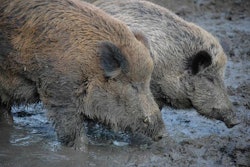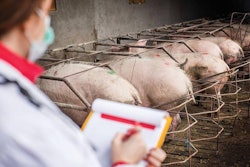
Trade shifts, an ASF-driven protein gap and high consumer demand point to stable growth for the global poultry sector in the year ahead.
The demand for animal proteins remains strong worldwide. According to the United Nations’ Food and Agriculture Organization (FAO), global meat prices increased by 4.6% in November 2019, the largest monthly rise in more than a decade and a figure 17% higher than 12 months prior.
Globally, consumer demand for poultry meat and eggs has maintained its upward trajectory. Poultry production grew by 2.4% in 2019 and preliminary forecasts point to moderate growth (1.5%) in 2020, analysts at IEG Vantage – Agribusiness Intelligence report.
While experts remain “cautiously optimistic,” several trends and extraneous factors may enhance — or complicate — industry profitability and feed production in the year ahead.
6 critical issues influencing global poultry production
Poultry industry stakeholders weigh in on the 2020 issues feed manufacturers and nutritionists should have on their radar.
1. China & African swine fever (ASF)
In 2019, ASF reduced the Chinese swine herd by more than 50% and has doubled the cost of pork in the world’s largest pork consuming country. Unsurprisingly, poultry has risen as the substitute to fill the protein supply gap.
According to Rabobank, China increased meat imports by double digits across all species in 2019, with poultry imports up by 51% (Jan-Sep YOY), predicting expanded import growth moving forward.
The recent lift of China’s nearly five-year ban on U.S. poultry imports means added growth and demand for U.S. producers, in addition to its already strong domestic demand.
“ASF has presented an opportunity for the U.S. market to grow poultry exports to affected markets,” explains Greg Tyler, senior vice president of marketing, USA Poultry & Egg Export Council (USAPEEC). United Soybean Board vice president of meal strategy, Keenan McRoberts, agrees and suggests industry trade associations and their partners work together to seize this near-term opportunity and ensure a long-term, sustained poultry trade.
Estimates suggest the U.S. poultry industry’s opportunity in China could be as high as US$1 billion in 2020, but IEG Vantage is a bit more conservative in its prediction.
“While there is optimism about the export opportunity in China, that optimism might be a little bit far fetched,” warns Brian Earnest, commodity market analyst, IEG Vantage at Agribusiness Intelligence. “[China’s] need is immediate, as preparations are made for Chinese New Year. China has been aggressive in opening markets and approving plants and could very easily decide to block imports at any time, as they did with pork from Canada earlier this year.”
In the meantime, while still rebounding from the poultry disease losses of several years ago, the Chinese are making significant investments to expand poultry production, which has increased by nearly 20% since 2018.
According to Novus International’s products and solutions vice president and CIO, Scott Hine, reports suggest Chinese poultry feed production will nearly double by 2025.
2. Trade shifts & uncertainty
Trade movement and geopolitical tension will be a hot topic in 2020 as much uncertainty prevails.
“Trade disruption and trade opportunities introduce a fair amount of unpredictability into pricing and demand,” explains Christine McCracken, executive director – animal protein, Rabobank. “Whenever markets are lost or gained, it’s disruptive to the overall complex and it will continue to be a source of consternation for the industry.”
As more than 20 countries suffer the losses of ASF, the virus will also play a direct role in shifting global trade patterns, as countries that historically haven’t exported to Asia enter new markets and cease exporting to their traditional customers, McCracken says.
Meanwhile, major international trade agreements, such as the United States-Mexico-Canada Agreement (USMCA), remain unresolved.
“Prepare for volatility and make sure that you manage your risk,” McCracken says. “Given how exposed the entire market is to trade action, you need to be able to react fairly quickly.”
3. Regulatory threats
The ongoing threat of new regulations dictating poultry industry processing and production practices — potentially limiting its growth — is an evergreen concern.
“I think there is a lot of change being mandated by legislation and, to me, that’s risky,” McCracken says. “Whenever you have lawmakers deciding what’s best for your operations, it’s never ideal.”
4. Labor shortages
The U.S. poultry industry faces historically low domestic unemployment rates and increased workforce scrutiny targeting illegal immigrants.
Workforce shortages, however, extend beyond the processing plant and the farm.
“According to the U.S. Bureau of Labor Statistics, the projected job growth for animal scientists is 7% from 2018-2028 — but where will these educated and knowledgeable nutritionists and veterinarians come from?” Hine asks. “The struggle to secure talented, committed employees isn’t only happening in the processing parts of our industry and this is a challenge that needs to be addressed now, not when someone retires or changes companies.”
To fill the need for veterinarians and nutritionists, he suggests animal ag industry stakeholders push to promote animal sciences in primary and secondary education Science, Technology, Engineering and Mathematics (STEM) programs.
5. Antibiotic-free production
Globally, the push toward the elimination and reduction of antibiotics in poultry production forges ahead with significant success.
“The adaptation of no-antibiotics-ever (NAE) production forced the industry to think outside the box in terms of feeding,” Earnest says. “We’ve seen improvements this year in livability and production growth as a result of changing those dietary needs in reaction to the reduction of antibiotic use.”
As more countries move away from antibiotic growth promoters (AGPs) in 2020, for example, China, Hine predicts the demand for feed additives to improve efficiency and manage production costs will remain high.
“When antibiotics are banned, whether growth promoters or ionophores, you are faced with a direct or indirect drop in performance — FCR downgrades, wet droppings, higher mortality, subclinical disease, etc. —, so the cost of production increases because you have to invest in alternative solutions to recover the performance levels found with antibiotics,” explains Eric Beaufils, Wisium poultry nutritionist.
Meanwhile, AnimalhealthEurope, an association of European animal medicine manufacturers and national associations, and global veterinary medicine industry association HealthforAnimals have pledged to collaborate to develop “clear, measurable global actions to improve the prevention, detection and treatment of animals by 2025.”
“Those on the pharmacological side of the industry are putting themselves on notice that they’ll need more options as they help producers reduce the risk of and treat diseases,” Hine notes.
6. Consumer trends to watch
The following four consumer trends impacted poultry demand, production and product development in 2019 and will likely continue to be influential in 2020.
- Rising popularity of plant-based animal protein alternatives
According to Rabobank, in the U.S. and Europe, alternative proteins have grown by double digits year over year (16% since 2018). However, according to Nan-Dirk Mulder, Rabobank senior analyst – animal protein, on a global level, the segment made up less than 1% of the total market.
With the recent boom of plant-based meat alternatives stealing headlines, consumers have been willing to put their money where their mouth is. The trend has prompted large poultry product manufacturers to dabble with their own meatless alternatives and meat-plant hybrid products.
“In the coming years, alternative proteins are a way to expand your markets and supply consumers who haven’t been your customers before, such as vegetarians,” Mulder says.
In addition to becoming a viable center-plate protein option, the success of the “second generation” of meat alternative products signals that consumers are questioning whether they should be eating traditional animal proteins.
“As technology improves and the price comes down, plant-based alternatives are going to be an ongoing threat,” McCracken says.
- Dark meat gains popularity
In 2019, broiler producers saw a boost in dark meat disappearance — a trend that will continue into 2020.
“On the demand side, there has been a shift in consumer purchasing behavior, which is now more inclusive of dark meat this year than what we have seen in the past,” Earnest says.
He believes woody breast syndrome played a role in shifting consumer preferences away from white meat. In addition, modern diets focus on more protein, flavor and palatability rather than low-calorie, low-fat meats.
“Breast meat prices are sitting at near historic lows, but dark meat prices were up roughly 25% this year on an annualized basis,” he says.
- Differentiation builds poultry demand
Poultry producers are embracing differentiation to market their products.
“Many of the bigger acquisitions are targeting the value-added segment and also the concept poultry market,” Mulder says.
Mulder predicts concept poultry offerings such as slower-growing chicken, free-range and organic meat and eggs will continue to develop.
“Europe will see its share of concept poultry rise to 9% of the total market in 2020 and other developed markets will follow suit,” he says, noting that emerging markets are also exploring these to differentiate their portfolio. “In the U.S. egg sector, the move toward cage-free will continue, but with ongoing uncertainty about the speed of transformation as there is a constant challenge in balancing supply and demand.”
- Animal welfare and sustainability
In 2020 and beyond, animal welfare and sustainability will continue to gain traction and shape poultry production.
“I think there are a lot of new influences that will impact how [poultry] is raised and what’s consider high quality — whether NAE or organic —, we continue to see market fragmentation,” McCracken says.
Poultry feed trends
Global feed prices are expected to remain neutral in 2020. However, Earnest warns producers have benefited from a favorable, steady feeding environment for several years and he fears they may have grown numb to the vast fluctuations of years past.
“From a feed perspective, anything that would impact the cost of feed or inclusions obviously could raise a lot of issues in terms of productivity,” McCracken says. “Not only competition for some feedstuffs, but new import and export regulations for feedstuffs and ingredients to control diseases may make it more challenging moving forward.”
New legislative measures driven by animal welfare advocates could add costs for broiler and egg producers if diets must be modified to support new production systems.
From an ingredient standpoint, Hine notes a growing interest in alternative protein feed ingredients such as single-cell proteins, insects and algae.
“Consumer interest in ‘new’ ingredients is developing, but producers will need to ask how those feed ingredients will respond to trusted feed additives and production parameters,” he says.
The examination of animal feed’s role in combating climate change is gaining interest. To reduce poultry emissions, for example, Jan Vervloesem, Nuscience/Royal Agrifirm Group global category manager – poultry feed additives, suggests nutritionists focus on limiting undigested protein to improve intestinal health and reduce nitrogen production.
“Nutritionists must understand the individual needs of each flock at any stage and value the raw materials and feed more precisely to improve protein efficiency,” he says.
As the feed additive space grows more competitive, Hine urges nutritionists to ask suppliers more questions and to make sure they fully understand the science behind the different types of additives to make the best decisions for the flock and their bottom line.

















